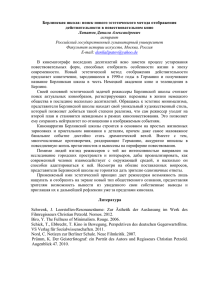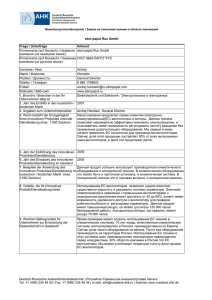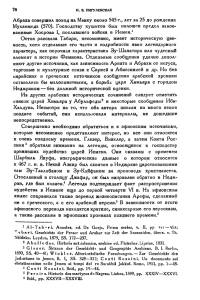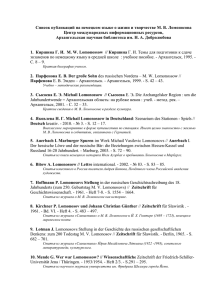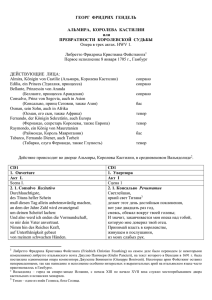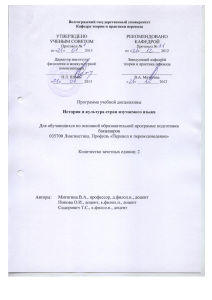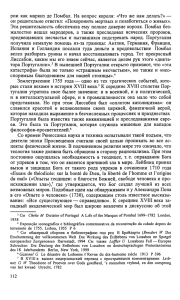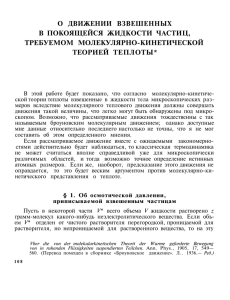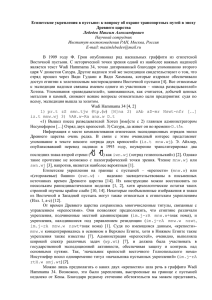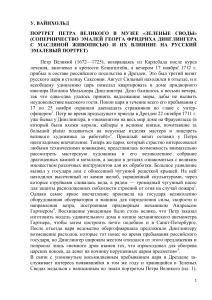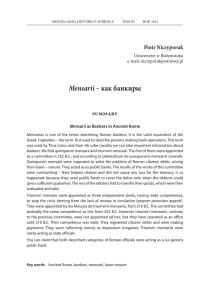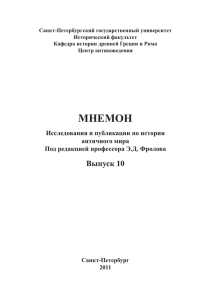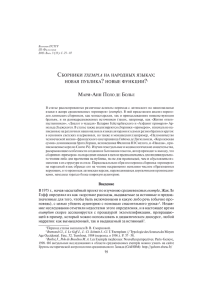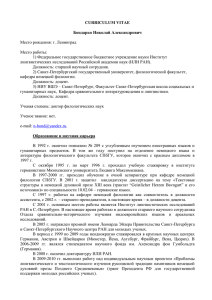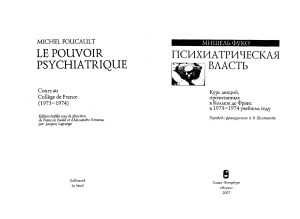«ЦЕРКОВНАЯ ИСТОРИЯ» ГЕЛАСИЯ КИЗИКИЙСКОГО И ПОХОД
advertisement
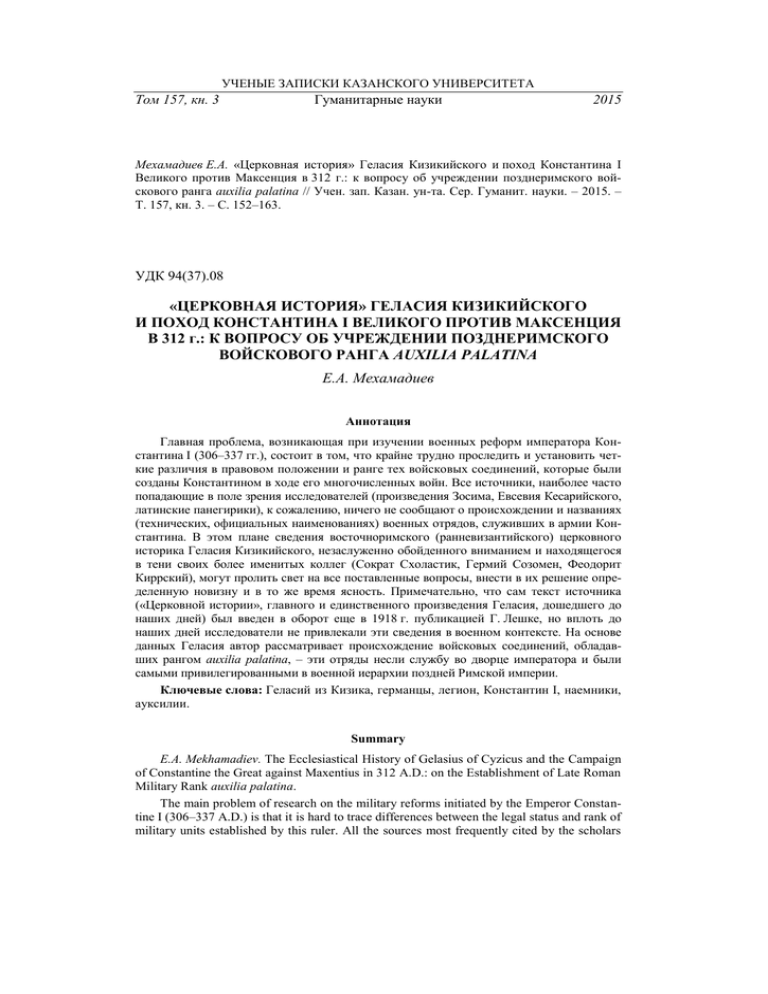
УЧЕНЫЕ ЗАПИСКИ КАЗАНСКОГО УНИВЕРСИТЕТА Том 157, кн. 3 Гуманитарные науки 2015 Мехамадиев Е.А. «Церковная история» Геласия Кизикийского и поход Константина I Великого против Максенция в 312 г.: к вопросу об учреждении позднеримского войскового ранга auxilia palatina // Учен. зап. Казан. ун-та. Сер. Гуманит. науки. – 2015. – Т. 157, кн. 3. – С. 152–163. УДК 94(37).08 «ЦЕРКОВНАЯ ИСТОРИЯ» ГЕЛАСИЯ КИЗИКИЙСКОГО И ПОХОД КОНСТАНТИНА I ВЕЛИКОГО ПРОТИВ МАКСЕНЦИЯ В 312 г.: К ВОПРОСУ ОБ УЧРЕЖДЕНИИ ПОЗДНЕРИМСКОГО ВОЙСКОВОГО РАНГА AUXILIA PALATINA Е.А. Мехамадиев Аннотация Главная проблема, возникающая при изучении военных реформ императора Константина I (306–337 гг.), состоит в том, что крайне трудно проследить и установить четкие различия в правовом положении и ранге тех войсковых соединений, которые были созданы Константином в ходе его многочисленных войн. Все источники, наиболее часто попадающие в поле зрения исследователей (произведения Зосима, Евсевия Кесарийского, латинские панегирики), к сожалению, ничего не сообщают о происхождении и названиях (технических, официальных наименованиях) военных отрядов, служивших в армии Константина. В этом плане сведения восточноримского (ранневизантийского) церковного историка Геласия Кизикийского, незаслуженно обойденного вниманием и находящегося в тени своих более именитых коллег (Сократ Схоластик, Гермий Созомен, Феодорит Киррский), могут пролить свет на все поставленные вопросы, внести в их решение определенную новизну и в то же время ясность. Примечательно, что сам текст источника («Церковной истории», главного и единственного произведения Геласия, дошедшего до наших дней) был введен в оборот еще в 1918 г. публикацией Г. Лешке, но вплоть до наших дней исследователи не привлекали эти сведения в военном контексте. На основе данных Геласия автор рассматривает происхождение войсковых соединений, обладавших рангом auxilia palatina, – эти отряды несли службу во дворце императора и были самыми привилегированными в военной иерархии поздней Римской империи. Ключевые слова: Геласий из Кизика, германцы, легион, Константин I, наемники, ауксилии. Summary E.A. Mekhamadiev. The Ecclesiastical History of Gelasius of Cyzicus and the Campaign of Constantine the Great against Maxentius in 312 A.D.: on the Establishment of Late Roman Military Rank auxilia palatina. The main problem of research on the military reforms initiated by the Emperor Constantine I (306–337 A.D.) is that it is hard to trace differences between the legal status and rank of military units established by this ruler. All the sources most frequently cited by the scholars (Eusebius of Caesarea, Zosimus, Latin Panegyrics), unfortunately, specify nothing on the origin and titles of all the detachments, which fought together with Constantine against Maxentius and Licinius, his main rivals. In this respect, the data provided by Gelasius of Cyzicus in his neglected Ecclesiastical History may clarify some aspects of this problem despite that the text itself was published as early as 1918. However, this source has not drawn attention of the scholars, who traditionally relied on more famous ancient writers. On the basis of Gelasius’ evidence, the origin of military units, which received the title of auxilia palatina in the Late Roman military hierarchy, was considered in this paper. Solution to the discussed problem is directly associated with the involvement and role of the German tribes in Constantine’s army. The evidence presented by Gelasius help to understand the kinds of this involvement and how differences in service influenced the formation of auxilia palatina rank. Keywords: Gelasius of Cyzicus, Germans, legion, Constantine I, mercenaries, auxiliaries. Источники AE – L’Année épigraphique. – Paris, 1889–. CIL – Corpus Inscriptionum Latinarum. – Berlin, 1863–1959. – V. I–XVI. D – Dessau H. Inscriptiones Latinae Selectae. – Berolini, 1892–1916. – V. 1–4. Gel. Cyz. HE – Anonyme Kirchengeschichte (Gelasius Cyzicenus, CPG 6034) / Hrsg. G.C. Hansen. – Berlin: De Gruyter, 2002. – LVIII + 201 S. Jul. Or. – L’empereur Julien. Oeuvres completes / Ed. J. Bidez. – Paris: Les Belles Lettres, 1932. – V. 1.1. – XXVIII + 235 p. Paneg. Lat. – In Praise of Later Roman Emperors. The Panegyrici Latini / Introd., transl., historical comm. with the Latin text of R.A.B. Mynors. Ed. C.E.V. Nixon, B.S. Rodgers. – Berkeley; Los Angeles; Oxford: Univ. California Press, 1994. – XII + 736 p. Lact. mort. pers. – Laktanz: De mortibus persecutorum = Die Todesarten der Verfolger / Übers. A. Städele. – Turnhout: Brepols Publ., 2003. – 270 S. Opt. Porf. Carm. – Publilii Optatiani Porfyrii Carmina / Rec. L. Mueller. – Lipsiae: In aedibus B.G. Teubneri, 1877. – XLIV + 76 p. Julian, Works – The Works of the Emperor Julian / With Eng. transl. by W.C. Wright. – London: William Heinemann, 1913. – V. I. – XIV + 510 p. Zos. – Zosime: Histoire Nouvelle / Ed. F. Paschoud. – Paris: Les Belles Lettres, 1971–1989. – V. 1–3. Литература 1. 2. 3. 4. 5. 6. Marasco G. The Church Historians (II): Philostorgius and Gelasius of Cyzicus // Greek & Roman Historiography in Late Antiquity: Fourth to Sixth Century A.D. / Ed. G. Marasco. – Leiden: Brill, 2003. – P. 257–288. Cullhed M. Conservator urbis suae. Studies in the politics and propaganda of the emperor Maxentius. – Stockholm: Åström, 1994. – 108 p. Winkelmann F. Die Quellen der Historia Ecclesiastica des Gelasius von Cyzicus (nach 475) // Byzantinoslavica. – 1966. – V. 27. – S. 104–130. Winkelmann F. Untersuchungen zur kirchengeschichte des Gelasios von Kaisareia. – Berlin: Akademie-Verlag, 1966. – 123 S. Winkelmann F. Das Problem der Rekonstruktion der Historia Ecclesiastica des Gelasius von Caesarea // Forschungen und Fortschritte. – 1964. – Bd. 38. – S. 311–314. Winkelmann F. Zu einer Edition der Fragmente der Kirchengeschichte des Gelasios von Kaisareia // Byzantinoslavica. – 1973. – V. 34. – S. 193–198. 7. 8. 9. 10. 11. 12. 13. 14. 15. 16. 17. 18. 19. 20. 21. 22. 23. 24. Winkelmann F. Charakter und Bedeutung der Kirchengeschichte des Gelasios von Kaisareia // Byzantinische Forschungen. – 1966. – Bd. 1. – S. 346–385. Nautin P. La continuation de l’“Histoire ecclésiastique” d’Eusèbe par Gélase de Césarée // Revue des études byzantines. – 1992. – V. 50. – P. 163–183. Winkelmann F. Zur nacheusebianischen christlichen Historiographie des 4. Jahrhunderts // Πολυπλευρος νους: Miscellanea für Peter Schreiner zu seinem 60. Geburtstag / Hrsg. C. Scholz, G. Makris. – München; Leipzig: K.G. Saur, 2000. – S. 404–414. Barnes T.D. Publilius Optatianus Porfyrius // Am. J. Philology. – 1975. – V. 96, No 2. – P. 173–186. Ehrhardt C. Constantinian Documents in Gelasius of Cyzicus’ Ecclesiastical History // Jahrb. Antike und Christentum. – 1980. – V. 23. – P. 48–57. Zuckerman C. Comtes et ducs en Égypte autour de l’an 400 et la date de la Notitia Dignitatum Orientis // Antiquité Tardive. – 1998. – V. 6. – P. 137–147. Kulikowski M. The “Notitia Dignitatum” as a Historical Source // Historia. – 2000. – V. 49. – P. 358–377. Grünewald Th. Ein epigraphisches Zeugnis zur Germanenpolitik Konstantins des Grossen: Die Bauinschr. des Deutzer Kastells (CIL XIII 8502) // Labor omnibus unus: Gerold Walser zum 70. Geburtstag dargebracht von Freunden, Kollegen und Schülern / Hrsg. H.E. Herzig, R. Frei-Stolba. – Stuttgart: F. Steiner-Verlag, 1989. – S. 171–185. Moreau J. Zur spätrömischen Heeresreform // Moreau J. Scripta minora. – Heidelberg: Carl Winter, 1964. – S. 42–50. Berchem D. van. L’armée de Dioclétien et la réforme constantinienne. – Paris: P. Geuthner, 1952. – 130 p. Colombo M. Constantinus rerum novator: dal comitatus dioclezianeo ai palatini di Valentiniano I // Klio. – 2008. – V. 90/1. – P. 124–161. Hoffmann D. Das spätrömische Bewegungsheer und die Notitia Dignitatum. – Düsseldorf: Rheinland-Verlag, 1969. – Bd. I. – XV + 531 S. Manella G. La campagna di Costantino nell’ Italia nord-occidentale: la documentazione epigrafica // L’armée romaine de Dioclétien à Valentinien Ier. Actes du Congrès de Lyon (12–14 sept. 2002) / Eds. Y. Le Bohec, C. Wolf. – Paris: De Boccard, 2004. – P. 359–371. Schmitt O. Stärke, Struktur und Genese des comitatensischen Infanterienumerus // Bonner Jahrb. – 2001 [2004]. – Bd. 201. – S. 93–110. Zuckerman C. Les “Barbares” romains: au sujet de l’origine des auxilia tétrarchique // L’armée romaine et les barbares du IIIe au VIIe siècle / Ed. M. Kazanski. – Rouen: Association française d’archéologie mérovingienne, 1993. – P. 17–20. Speidel M.P. Raising New Units for the Late Roman Army: Auxilia Palatina // Dumbarton Oaks Papers. – 1996. – V. 50. – P. 163–170. Speidel M.P. The Four Earliest Auxilia Palatina // Revue des études militaires anciennes. – 2004. – V. 1. – P. 133–146. Simpson J. Laeti in the Notitia Dignitatum. “Regular” Soldiers vs. “Soldier-Farmers” // Rev. belge philol. his. –1988. – V. 66. – P. 80–85. Поступила в редакцию 01.10.14 Мехамадиев Евгений Александрович – кандидат исторических наук, старший преподаватель кафедры истории средних веков, Санкт-Петербургский государственный университет, г. Санкт-Петербург, Россия. E-mail: mehamadiev@gmail.com
